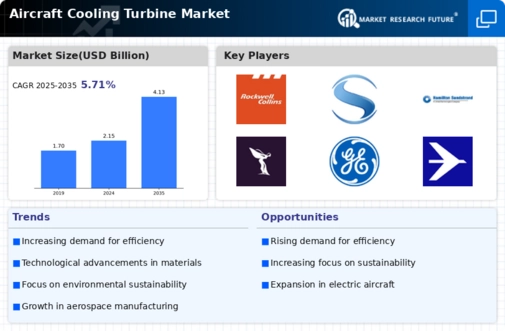Market Growth Projections
The Global Aircraft Cooling Turbine Market Industry is projected to experience substantial growth in the coming years. With a market value expected to reach 2.15 USD Billion in 2024, the industry is on a trajectory of expansion driven by various factors, including technological advancements and increasing air travel. The anticipated compound annual growth rate of 6.12% from 2025 to 2035 further underscores the positive outlook for the market. This growth is indicative of the industry's responsiveness to evolving demands and regulatory pressures, positioning it as a critical component of the aviation sector's future. The market's expansion reflects broader trends in sustainability and efficiency within the aerospace industry.
Rising Demand for Fuel Efficiency
The Global Aircraft Cooling Turbine Market Industry experiences a surge in demand driven by the aviation sector's focus on fuel efficiency. Airlines are increasingly investing in advanced cooling turbine technologies to optimize engine performance and reduce fuel consumption. This trend is particularly evident as the market is projected to reach 2.15 USD Billion in 2024, reflecting a growing emphasis on sustainable aviation practices. Enhanced cooling systems contribute to improved thermal management, which is crucial for maintaining optimal engine temperatures. Consequently, this demand for innovative cooling solutions is likely to propel the market forward, aligning with global efforts to minimize carbon emissions in the aviation industry.
Growth in Air Travel and Fleet Expansion
The Global Aircraft Cooling Turbine Market Industry benefits from the ongoing growth in air travel and fleet expansion. As global passenger traffic continues to rise, airlines are compelled to expand their fleets to accommodate increasing demand. This expansion necessitates the integration of advanced cooling turbine systems to ensure optimal engine performance and reliability. The aviation sector's recovery and growth trajectory suggest a sustained demand for innovative cooling solutions. Consequently, the market is poised for growth, with projections indicating a potential increase to 4.13 USD Billion by 2035. This trend underscores the interdependence between air travel growth and the need for efficient cooling technologies.
Technological Advancements in Turbine Design
Technological advancements play a pivotal role in shaping the Global Aircraft Cooling Turbine Market Industry. Innovations in materials and design methodologies enhance the efficiency and reliability of cooling turbines. For instance, the integration of lightweight composite materials and advanced computational fluid dynamics in turbine design leads to improved thermal performance. These advancements not only optimize engine cooling but also contribute to overall aircraft performance. As the industry evolves, manufacturers are likely to invest in research and development to create next-generation cooling solutions, which could further drive market growth. The anticipated market expansion to 4.13 USD Billion by 2035 underscores the importance of these technological developments.
Emerging Markets and Investment Opportunities
Emerging markets present significant opportunities for the Global Aircraft Cooling Turbine Market Industry. Countries in Asia-Pacific and Latin America are witnessing rapid growth in their aviation sectors, driven by rising disposable incomes and increasing urbanization. This growth translates into a higher demand for aircraft and, consequently, advanced cooling turbine technologies. Investment in infrastructure and aviation capabilities in these regions is likely to stimulate market expansion. As manufacturers seek to capitalize on these opportunities, the market is expected to experience robust growth, potentially reaching 4.13 USD Billion by 2035. This trend highlights the strategic importance of emerging markets in shaping the future of the cooling turbine industry.
Regulatory Compliance and Environmental Standards
The Global Aircraft Cooling Turbine Market Industry is significantly influenced by stringent regulatory compliance and environmental standards. Governments worldwide are implementing regulations aimed at reducing emissions and enhancing fuel efficiency in aviation. This regulatory landscape compels manufacturers to innovate and adopt advanced cooling turbine technologies that meet these standards. As a result, the demand for efficient cooling systems is expected to rise, fostering market growth. The projected compound annual growth rate of 6.12% from 2025 to 2035 indicates a robust response from the industry to align with evolving regulations. This trend not only supports environmental goals but also enhances the competitive positioning of manufacturers.













